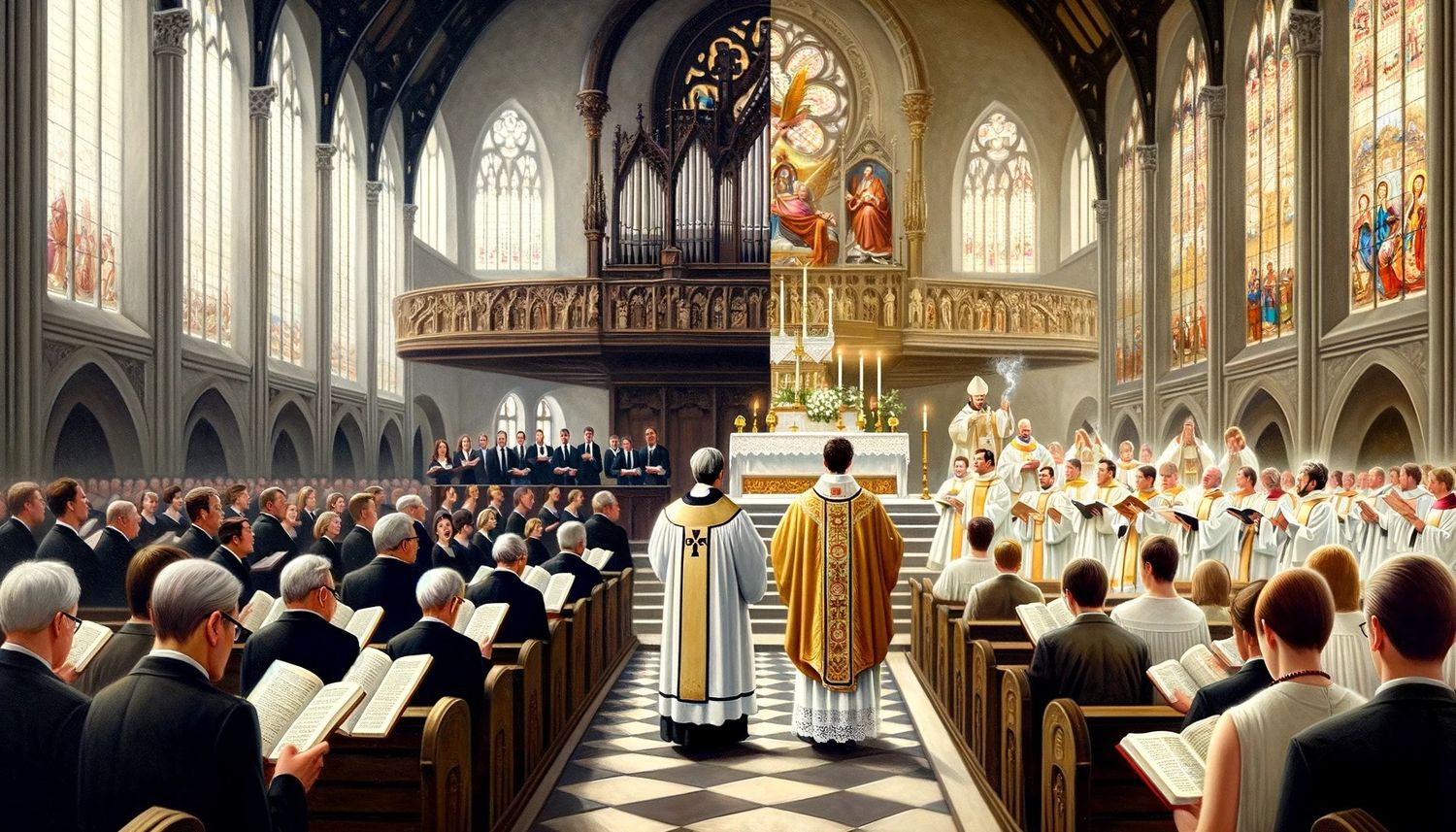Home>Arts and Culture>How Does Gospel Music Differ From Traditional European Hymns


Arts and Culture
How Does Gospel Music Differ From Traditional European Hymns
Published: March 7, 2024
Ericka Andersen, an editor at Christian.net, expertly merges digital strategy with content creation, focusing on faith and societal issues. Her communication skills enhance the platform's engaging narratives, fostering meaningful dialogue on belief's impact on society.
Discover the distinctions between gospel music and traditional European hymns in this insightful exploration of arts and culture. Explore the rich history and unique characteristics of these two musical traditions.
(Many of the links in this article redirect to a specific reviewed product. Your purchase of these products through affiliate links helps to generate commission for Christian.net, at no extra cost. Learn more)
Table of Contents
- Introduction
- Historical Background of Gospel Music
- Historical Background of Traditional European Hymns
- Musical Characteristics of Gospel Music
- Musical Characteristics of Traditional European Hymns
- Cultural and Religious Influences on Gospel Music
- Cultural and Religious Influences on Traditional European Hymns
- Impact and Influence of Gospel Music
- Impact and Influence of Traditional European Hymns
- Conclusion
Introduction
How does Gospel music differ from traditional European hymns? This question delves into the heart of two distinct musical traditions that have played significant roles in religious worship and cultural expression. Gospel music and traditional European hymns have unique historical, musical, and cultural characteristics that set them apart. Understanding the differences between these two forms of religious music can provide insight into the diverse ways in which people express their faith and spirituality through music. In this article, we will explore the historical background, musical characteristics, and cultural influences of both Gospel music and traditional European hymns to gain a deeper understanding of their differences and significance.
Read more: What Are Traditional Hymns?
Historical Background of Gospel Music
-
Roots in African American Culture: Gospel music has its roots in the African American religious experience. It emerged during the late 19th and early 20th centuries as a form of expression for African American Christians. The music was deeply influenced by the experiences of slavery, segregation, and the quest for freedom and equality. This historical context shaped the emotional and powerful nature of Gospel music, reflecting the struggles and triumphs of the African American community.
-
Influence of Spirituals and Hymns: Gospel music evolved from the rich tradition of spirituals and hymns sung by African American slaves and later by congregations in churches. These spirituals and hymns served as the foundation for Gospel music, incorporating elements of call-and-response, emotional fervor, and a focus on personal testimony and faith.
-
Rise of Gospel Choirs and Quartets: In the early 20th century, Gospel music gained popularity through the formation of Gospel choirs and quartets. These groups traveled and performed, spreading the message of faith and hope through their music. The harmonious blend of voices and the passionate delivery of Gospel lyrics became defining features of the genre.
-
Integration of Blues and Jazz: Gospel music also drew inspiration from the musical styles of blues and jazz, incorporating elements of rhythm, improvisation, and soulful melodies. This fusion of musical influences contributed to the dynamic and vibrant nature of Gospel music, setting it apart from traditional European hymns.
-
Role in Civil Rights Movement: Gospel music played a pivotal role in the Civil Rights Movement, providing a soundtrack of resilience and determination for those fighting against racial injustice. Songs such as "We Shall Overcome" and "Precious Lord, Take My Hand" became anthems of hope and solidarity, uniting people in their quest for equality and freedom.
-
Evolution and Contemporary Influence: Over time, Gospel music has continued to evolve, embracing modern musical styles and technologies while maintaining its core message of faith, redemption, and praise. It has also influenced various genres of popular music, leaving a lasting impact on the global music landscape.
The historical background of Gospel music reflects its deep roots in African American culture, its evolution as a form of religious expression, and its enduring impact on both religious and secular music traditions.
Historical Background of Traditional European Hymns
-
Early Christian Chant and Plainchant: Traditional European hymns trace their origins to the early Christian period, where the use of chant and plainchant formed the basis of musical worship. These monophonic melodies, often sung in Latin, were integral to the liturgical practices of the early Christian church, providing a solemn and reverent atmosphere for religious ceremonies.
-
Gregorian Chant and Liturgical Hymnody: The development of Gregorian chant in the medieval period further solidified the tradition of hymnody in European religious music. Gregorian chant, named after Pope Gregory I, became the standard form of liturgical music in Western Christianity, with its melodies and texts serving as the foundation for traditional European hymns.
-
Influence of Protestant Reformation: The Protestant Reformation in the 16th century brought about significant changes in the composition and use of hymns in European Christian worship. Reformers such as Martin Luther emphasized congregational singing and the use of vernacular languages, leading to the creation of hymns that were accessible to the common people and reflected the theological principles of the Reformation.
-
Hymnals and Sacred Music Composition: The printing of hymnals and the composition of sacred music by renowned composers such as Johann Sebastian Bach and George Frideric Handel further enriched the tradition of traditional European hymns. Hymnals became repositories of religious poetry and music, preserving and disseminating hymns across different Christian denominations and regions.
-
Role in Liturgical Worship: Traditional European hymns have been integral to liturgical worship in churches across Europe, providing a means for congregations to express their faith and devotion through communal singing. The hymns often reflect themes of praise, thanksgiving, repentance, and the theological tenets of Christian doctrine, serving as a vehicle for spiritual reflection and communal worship.
-
Continued Legacy and Adaptation: The legacy of traditional European hymns continues to endure, with hymnody remaining a vital component of Christian worship practices. While the musical styles and languages of hymns have evolved over time, the enduring themes of faith, reverence, and devotion remain central to the tradition of traditional European hymns.
The historical background of traditional European hymns underscores their deep roots in early Christian liturgical practices, their evolution through the Protestant Reformation, and their enduring legacy as a form of communal worship and spiritual expression.
Musical Characteristics of Gospel Music
-
Emotional Intensity: Gospel music is characterized by its emotional intensity and fervor. The passionate delivery of lyrics, often accompanied by soulful vocal expressions and dynamic musical arrangements, creates a deeply moving and uplifting experience for both performers and listeners.
-
Call-and-Response: A prominent feature of Gospel music is the use of call-and-response patterns, where a lead vocalist or choir sings a phrase that is then echoed or responded to by the congregation or another vocal group. This interactive musical style fosters a sense of unity and participation within the worship experience.
-
Rhythmic Dynamism: Gospel music is known for its rhythmic dynamism, often incorporating lively rhythms, syncopation, and energetic beats. These rhythmic elements contribute to the celebratory and joyous nature of Gospel music, inviting individuals to engage in physical expressions of praise and worship.
-
Harmonious Vocals: The harmonious blend of vocal parts, including richly layered harmonies and melismatic vocal embellishments, is a hallmark of Gospel music. This emphasis on vocal harmony creates a sense of unity and collective expression, enhancing the spiritual and emotional impact of the music.
-
Improvisation and Ad-Libitum Singing: Gospel music allows for improvisation and ad-libitum singing, giving performers the freedom to express their individual creativity and spontaneity within the musical framework. This improvisational aspect adds a sense of authenticity and personal testimony to Gospel performances.
-
Incorporation of Instrumentation: While Gospel music is rooted in vocal expression, it often incorporates a variety of musical instruments such as pianos, organs, drums, and guitars. These instruments contribute to the dynamic and vibrant sound of Gospel music, adding depth and texture to the overall musical arrangement.
-
Lyrically Reflective: The lyrics of Gospel music often reflect themes of faith, redemption, hope, and spiritual deliverance. They convey personal and communal experiences of struggle, triumph, and unwavering belief, resonating with the lived realities of the African American religious tradition and beyond.
-
Adaptive to Contemporary Styles: Gospel music has shown adaptability to contemporary musical styles, incorporating elements of R&B, soul, and even hip-hop, while retaining its core spiritual and emotive essence. This adaptability has allowed Gospel music to remain relevant and influential across diverse cultural and musical landscapes.
Understanding the musical characteristics of Gospel music provides insight into its expressive and dynamic nature, as well as its profound impact on religious worship and cultural expression.
Musical Characteristics of Traditional European Hymns
-
Melodic Simplicity: Traditional European hymns are known for their melodic simplicity, often featuring straightforward and easily singable tunes. This characteristic allows congregations to participate in communal singing, as the melodies are accessible and memorable, fostering a sense of unity and collective worship.
-
Strophic Structure: Many traditional European hymns follow a strophic structure, where the same melody is repeated for each stanza of the lyrics. This repetitive form enables congregations to internalize the melody and engage in sustained singing, creating a meditative and contemplative atmosphere during worship.
-
Emphasis on Harmonization: Traditional European hymns prioritize harmonization, with multiple vocal parts blending together to create a rich and resonant sound. The interweaving of vocal harmonies adds depth and emotional resonance to the music, enhancing the spiritual and aesthetic experience of hymn singing.
-
Use of Organ and Classical Instruments: Hymn singing in traditional European worship settings often involves accompaniment by the organ or other classical instruments such as strings or brass. The majestic and reverent tones of these instruments complement the vocal melodies, elevating the overall musical expression and creating a sense of grandeur in worship spaces.
-
Lyrical Theological Depth: The lyrics of traditional European hymns are characterized by their theological depth and doctrinal significance. Hymn writers often convey profound theological truths and spiritual insights through poetic and metaphorical language, providing a means for congregations to engage with and reflect on the core tenets of their faith.
-
Integration of Choral Settings: Traditional European hymns are frequently arranged in choral settings, allowing for the performance of hymns by choirs or vocal ensembles. These choral arrangements showcase the polyphonic textures and intricate vocal arrangements that are emblematic of traditional European choral music, adding a sense of reverence and artistry to hymn singing.
-
Adaptation of Folk Melodies: Many traditional European hymns have roots in folk melodies and secular tunes that were adapted for religious use. This integration of folk music elements into hymnody reflects the cultural and historical contexts in which these hymns originated, connecting the sacred music tradition with the broader musical heritage of European communities.
-
Role in Liturgical Seasons: Traditional European hymns are often associated with specific liturgical seasons and religious observances, with hymnody playing a central role in shaping the worship experience throughout the Christian calendar. Hymns tailored to Advent, Christmas, Lent, Easter, and other liturgical periods contribute to the spiritual journey of congregations and reinforce the significance of these seasons in Christian worship.
Understanding the musical characteristics of traditional European hymns illuminates their role in fostering congregational participation, conveying theological truths, and enriching the worship experience within the context of European Christian traditions.
Read more: How Are The Gospels Different
Cultural and Religious Influences on Gospel Music
The cultural and religious influences on Gospel music are deeply intertwined, shaping the music's lyrical themes, musical styles, and communal significance. These influences have played a pivotal role in defining the expressive and spiritual nature of Gospel music within the African American religious experience and beyond.
-
African American Spiritual Traditions: Gospel music is deeply rooted in the spiritual traditions of African American communities, drawing from the rich heritage of African rhythms, vocal expressions, and communal music-making. The call-and-response patterns, rhythmic vitality, and emotive vocal delivery in Gospel music reflect the influence of African musical traditions, connecting the music to the collective experiences and expressions of faith within African American culture.
-
Christian Evangelicalism and Pentecostalism: The rise of Gospel music is closely linked to the growth of Christian evangelicalism and Pentecostalism in the United States. These religious movements emphasized the personal experience of salvation, emotional worship, and the manifestation of spiritual gifts, all of which found resonance in the impassioned and exuberant musical expressions of Gospel music. The emphasis on personal testimony, spiritual empowerment, and the presence of the Holy Spirit in Gospel lyrics and performances reflects the influence of these Christian traditions.
-
Social and Political Context: The social and political context of African American history has profoundly influenced the themes and messages conveyed in Gospel music. The music served as a means of resilience, protest, and hope during periods of racial segregation, civil rights struggles, and social injustices. Songs such as "We Shall Overcome" and "A Change Is Gonna Come" became anthems of the Civil Rights Movement, embodying the collective aspirations for freedom, equality, and justice within African American communities.
-
Cultural Expressions of Faith and Identity: Gospel music has provided a platform for the expression of faith, identity, and communal solidarity within African American churches and communities. The music has served as a source of spiritual nourishment, emotional catharsis, and cultural pride, reflecting the enduring resilience and creativity of African American religious expression. The fusion of Gospel music with elements of blues, jazz, and soul music further underscores its role as a cultural and religious expression of African American identity.
-
Global Influence and Adaptation: The cultural and religious influences of Gospel music have transcended geographical boundaries, influencing diverse musical traditions and religious practices around the world. The emotive and celebratory nature of Gospel music has resonated with audiences across different cultural contexts, leading to the adaptation and incorporation of Gospel elements into various styles of worship music and popular music genres.
The cultural and religious influences on Gospel music have contributed to its enduring significance as a form of spiritual expression, cultural heritage, and musical innovation. The music continues to inspire and uplift individuals, transcending barriers and resonating with the universal human experiences of faith, hope, and resilience.
Cultural and Religious Influences on Traditional European Hymns
The cultural and religious influences on traditional European hymns have profoundly shaped the musical and spiritual landscape of Christian worship within European traditions. These influences have contributed to the development of hymnody as a form of communal expression, theological reflection, and cultural heritage, reflecting the diverse contexts in which traditional European hymns emerged and evolved.
-
Liturgical and Monastic Traditions: The early development of traditional European hymns was closely intertwined with the liturgical and monastic traditions of the Christian church. Monastic communities played a significant role in preserving and cultivating the musical and textual aspects of hymnody, fostering a tradition of contemplative and meditative singing within the monastic setting. The rhythmic and melodic patterns of early hymns were influenced by the cadences of liturgical chant and the devotional practices of monastic life, shaping the spiritual and aesthetic qualities of traditional European hymns.
-
Cultural Vernacular and Folk Melodies: The use of vernacular languages and the adaptation of folk melodies into hymnody reflected the cultural and linguistic diversity of European communities. Hymn writers often drew inspiration from local folk tunes and poetic traditions, infusing hymns with regional flavors and expressions. This cultural integration allowed congregations to connect with hymns on a personal and communal level, fostering a sense of cultural identity and shared heritage within the context of Christian worship.
-
Reformation and Protestant Hymnody: The Protestant Reformation brought about significant changes in the composition and use of hymns within European Christianity. Reformers such as Martin Luther and John Calvin emphasized congregational singing and the use of vernacular languages in hymnody, enabling the participation of the laity in worship through communal singing. The theological and doctrinal influences of the Reformation also shaped the lyrical content of hymns, emphasizing themes of grace, faith, and the authority of scripture.
-
Artistic and Musical Patronage: The patronage of church and secular authorities, as well as the contributions of renowned composers and poets, played a crucial role in the development of traditional European hymns. Hymnals and sacred music collections were often sponsored by ecclesiastical and noble patrons, leading to the preservation and dissemination of hymns across different regions and denominations. The musical compositions of composers such as Johann Sebastian Bach and George Frideric Handel elevated hymnody to a form of artistic expression, enriching the musical heritage of traditional European hymns.
-
Seasonal and Liturgical Significance: Traditional European hymns are closely associated with specific liturgical seasons, religious observances, and feast days within the Christian calendar. Hymns tailored to Advent, Christmas, Lent, Easter, and other liturgical periods contribute to the spiritual journey of congregations, reinforcing the theological and devotional significance of these seasons in Christian worship. The cultural and religious influences on hymnody are reflected in the thematic diversity and liturgical adaptability of traditional European hymns.
The cultural and religious influences on traditional European hymns have contributed to their enduring legacy as a form of communal worship, cultural expression, and spiritual reflection within European Christian traditions. The music continues to resonate with congregations, connecting them to their cultural heritage and theological heritage through the timeless melodies and lyrical depth of traditional European hymns.
Impact and Influence of Gospel Music
-
Spiritual Upliftment and Encouragement: Gospel music has had a profound impact on individuals and communities by providing spiritual upliftment and encouragement. The emotive and powerful nature of Gospel music has the ability to touch the hearts and souls of listeners, offering solace, hope, and a sense of connection to the divine. Through its uplifting lyrics and soul-stirring melodies, Gospel music has served as a source of strength and inspiration for those facing personal challenges, adversity, and moments of doubt. The music's ability to instill faith and resilience has made it a transformative force in the lives of many, fostering a deep sense of spiritual empowerment and renewal.
-
Cultural Expression and Identity: Gospel music has played a pivotal role in shaping the cultural expression and identity of African American communities and beyond. The music has provided a platform for the celebration of cultural heritage, religious traditions, and communal solidarity within African American churches and neighborhoods. Through its fusion of African musical elements, Christian evangelical fervor, and social commentary, Gospel music has become a symbol of cultural pride and resilience, reflecting the enduring spirit and creativity of African American religious expression. The music's influence has extended beyond its cultural origins, resonating with diverse audiences and communities, and contributing to the global appreciation of African American musical traditions.
-
Social and Political Activism: Gospel music has been a catalyst for social and political activism, particularly during the Civil Rights Movement in the United States. The music served as a powerful tool for advocacy, protest, and solidarity, amplifying the voices of those advocating for racial equality and justice. Songs such as "We Shall Overcome" and "Oh Freedom" became anthems of the movement, uniting individuals in their quest for civil rights and social change. The impassioned and defiant spirit of Gospel music provided a soundtrack for the struggle against racial segregation and systemic injustice, inspiring a sense of collective determination and resilience within the African American community and the broader civil rights movement.
-
Musical Innovation and Influence: Gospel music has been a source of musical innovation and influence, contributing to the evolution of various genres and styles of popular music. The dynamic and expressive qualities of Gospel music have left an indelible mark on the global music landscape, influencing genres such as R&B, soul, jazz, and even rock and roll. The vocal techniques, rhythmic vitality, and emotive delivery of Gospel music have been embraced and adapted by artists across different cultural and musical contexts, shaping the sound and spirit of contemporary popular music. The music's ability to transcend cultural boundaries and inspire diverse musical traditions underscores its enduring influence and relevance in the modern era.
-
Community and Communal Worship: Gospel music has fostered a sense of community and communal worship within African American churches and Christian congregations worldwide. The music's participatory nature, call-and-response patterns, and emphasis on congregational singing have created a shared experience of worship and praise, uniting individuals in their expressions of faith and devotion. Gospel music has served as a unifying force, bringing together diverse voices and backgrounds in a collective celebration of spirituality and musical expression. The music's impact on communal worship has reinforced the sense of belonging, fellowship, and shared spiritual journey within religious communities, contributing to the vitality and vibrancy of worship practices.
-
Global Reach and Cross-Cultural Exchange: Gospel music has transcended geographical boundaries, reaching audiences across the globe and contributing to cross-cultural exchange and appreciation. The music's universal themes of faith, redemption, and hope have resonated with diverse cultural and religious traditions, fostering a sense of interconnectedness and mutual understanding. Gospel music has been embraced in various international contexts, inspiring adaptations and collaborations that bridge cultural divides and celebrate the diversity of musical expression. The music's global reach has facilitated dialogue, mutual enrichment, and the celebration of shared human experiences, reinforcing its impact as a unifying and transformative art form.
The impact and influence of Gospel music have been far-reaching, encompassing spiritual, cultural, social, and musical dimensions. The music's ability to inspire, uplift, and unite individuals and communities underscores its enduring significance as a form of artistic expression, religious devotion, and cultural heritage.
Impact and Influence of Traditional European Hymns
-
Spiritual Reflection and Devotion: Traditional European hymns have had a profound impact on the spiritual lives of individuals and congregations within European Christian traditions. The timeless melodies and lyrical depth of hymns have provided a means for personal reflection, prayer, and devotion, fostering a deep sense of spiritual connection and contemplation. Through their theological richness and poetic beauty, hymns have served as vehicles for expressing faith, gratitude, and reverence, enriching the spiritual journey of worshippers and deepening their engagement with Christian doctrine and tradition.
-
Cultural Heritage and Continuity: The influence of traditional European hymns extends to the preservation and transmission of cultural heritage within European communities. Hymnody has been an integral part of the cultural fabric, reflecting the linguistic, musical, and artistic traditions of diverse European regions. The melodies and texts of hymns have been passed down through generations, serving as a link to the cultural heritage and historical narratives of European societies. The preservation of hymnody has contributed to the continuity of cultural identity and the celebration of shared heritage within European Christian communities.
-
Artistic Expression and Musical Legacy: Traditional European hymns have left a lasting imprint on the artistic and musical legacy of Western civilization. The compositions of hymn writers and the musical arrangements of hymnals have exemplified the intersection of faith, art, and creativity, elevating hymnody to a form of artistic expression. Renowned composers such as Johann Sebastian Bach and Felix Mendelssohn have contributed to the musical heritage of hymnody, infusing hymns with intricate harmonies, counterpoint, and orchestral accompaniments. The enduring musical legacy of traditional European hymns has enriched the repertoire of sacred music and choral compositions, inspiring generations of musicians and composers.
-
Community and Communal Worship: Traditional European hymns have fostered a sense of community and communal worship within European Christian congregations. The act of congregational singing, often accompanied by organ or choral arrangements, has created a shared experience of worship and praise, uniting individuals in their expressions of faith and devotion. Hymnody has provided a space for congregations to come together in collective worship, fostering a sense of fellowship, unity, and shared spiritual journey. The music's impact on communal worship has reinforced the sense of belonging and the vitality of congregational singing within religious communities.
-
Liturgical Significance and Sacred Tradition: Traditional European hymns have played a central role in shaping the liturgical practices and sacred traditions of European Christian worship. Hymns tailored to specific liturgical seasons and religious observances have contributed to the spiritual journey of congregations, reinforcing the theological and devotional significance of these seasons in Christian worship. The thematic diversity and liturgical adaptability of traditional European hymns have enriched the worship experience, providing a means for congregations to engage with the sacred narratives and theological truths of the Christian faith within the context of communal worship.
The impact and influence of traditional European hymns encompass spiritual, cultural, artistic, and communal dimensions, underscoring their enduring significance as a form of communal worship, cultural expression, and spiritual reflection within European Christian traditions.
Read more: How Does The Shape Of The Church Of San Vitale In Ravenna Differ From Traditional Basilica Design
Conclusion
In conclusion, the comparison of Gospel music and traditional European hymns reveals the rich diversity and profound significance of religious music within different cultural and historical contexts. Gospel music, rooted in the African American religious experience, embodies the resilience, creativity, and spiritual fervor of a community striving for freedom and equality. Its emotional intensity, cultural influences, and global impact have made it a transformative force in the realm of religious and popular music. On the other hand, traditional European hymns, with their melodic simplicity, theological depth, and cultural heritage, have shaped the spiritual and artistic landscape of European Christian worship. The enduring legacy of hymnody as a form of communal worship, cultural expression, and spiritual reflection underscores its timeless relevance and influence.
Both Gospel music and traditional European hymns have left indelible marks on the global music landscape, inspiring individuals, communities, and artists across diverse cultural and religious traditions. Their ability to convey the depths of faith, express the resilience of communities, and foster communal worship has solidified their roles as enduring forms of artistic expression and spiritual devotion. As we continue to appreciate and celebrate the diversity of religious music traditions, it is essential to recognize the profound impact and influence of Gospel music and traditional European hymns in shaping the spiritual, cultural, and musical tapestries of our world.













